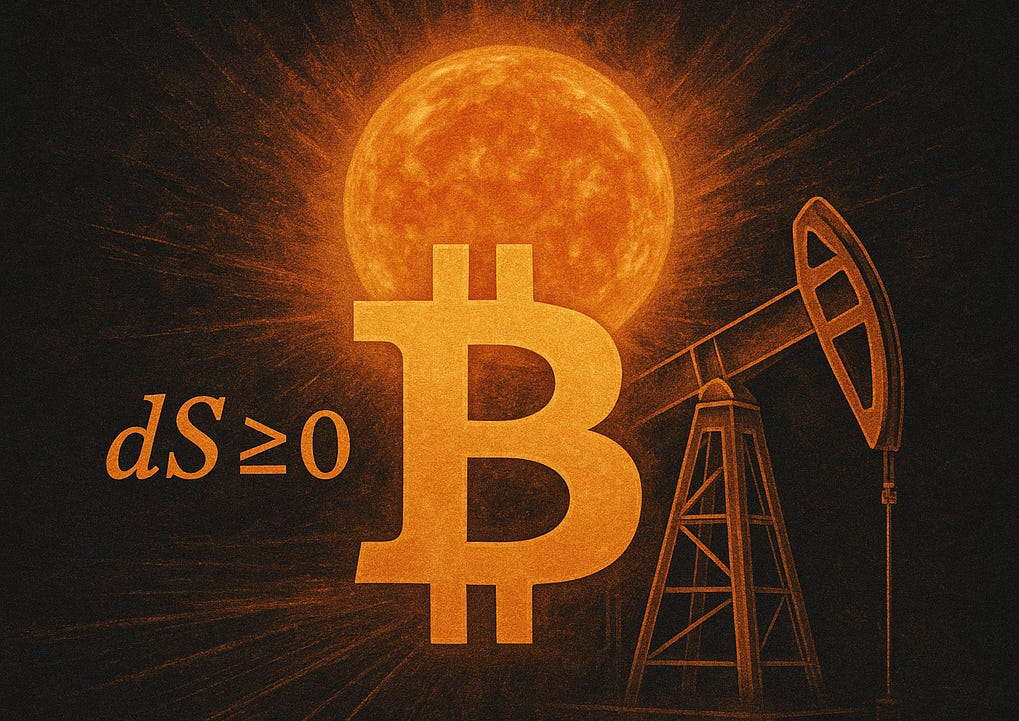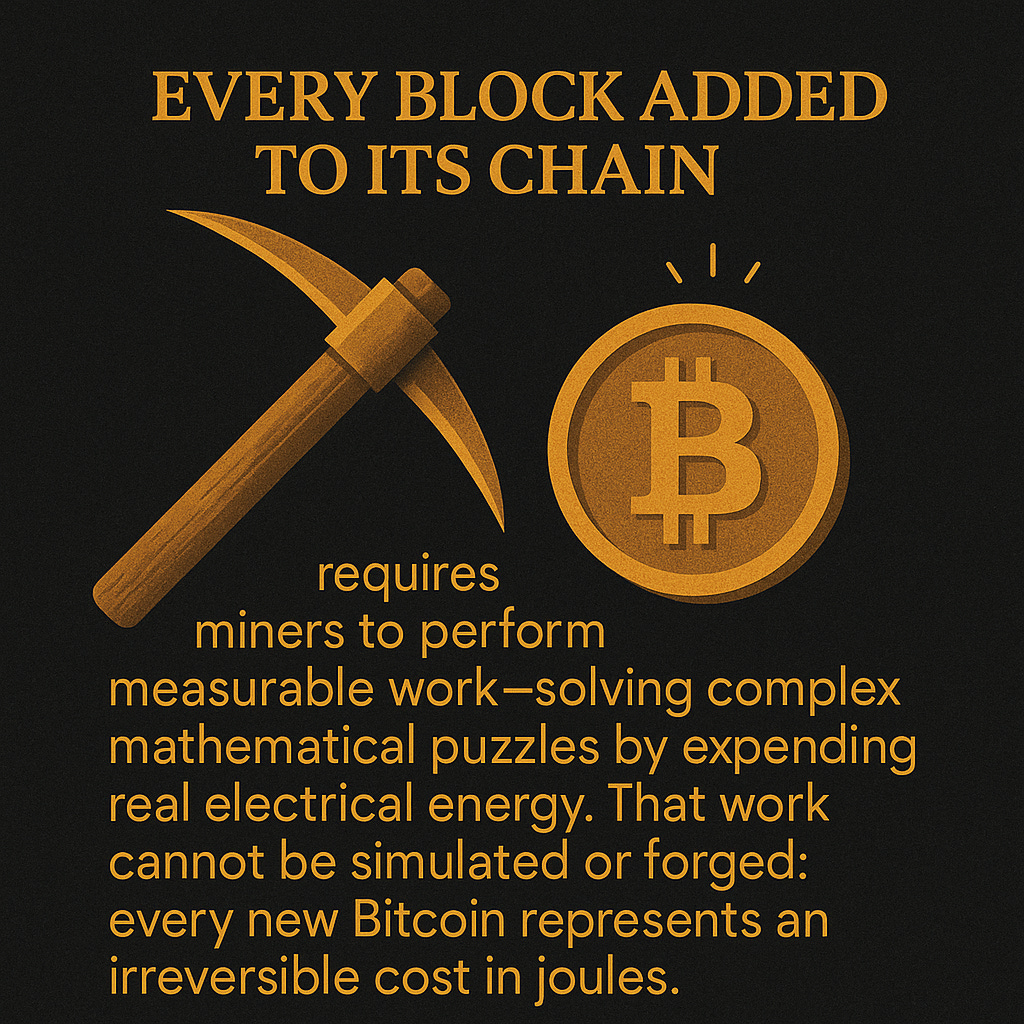Chapter 2: The Thermodynamic Future of Money Series
Bitcoin as the Thermodynamic Engine of Global Value
The Physics of Monetary Truth
Throughout every era of civilization, money has reflected the dominant energy system. Agricultural economies utilized grain and livestock as stores of value because calories were essential for survival. Industrial economies used gold and oil because they embodied extractable, transferable energy. The digital era, for the first time, requires a monetary foundation that can exist in cyberspace without losing its grounding in physics. Bitcoin uniquely fulfills that role.
It is not merely a financial innovation but a thermodynamic revolution. Its proof-of-work consensus mechanism transforms electricity into incorruptible information, linking economics directly to the immutable laws of the physical universe. By tying monetary issuance to real energy expenditure, Bitcoin achieves what no fiat or commodity system has before: a form of value that cannot be faked, inflated, or politically manipulated. It is the first monetary network to make the laws of thermodynamics its central bank.
Proof of Work and the Law of Energy Conservation
Bitcoin’s proof-of-work (PoW) system enforces scarcity through physics rather than policy. Every block added to its chain requires miners to perform measurable work—solving complex mathematical puzzles by expending real electrical energy. That work cannot be simulated or forged. It must obey the conservation of energy: every new Bitcoin represents an irreversible cost in joules.
This connection between energy and issuance is revolutionary.
Traditional money relies on social consensus, credit systems, and trust in central authorities. Bitcoin relies on physics. It takes electricity, computation, and time (three fundamental constants of the universe), and converts them into verifiable digital property. In doing so, it anchors economic truth to natural law and sovereign ownership.
Each validated block becomes a timestamp of exerted energy, an immutable record of work performed on Earth. Unlike government-issued currencies, whose ledgers are completely opaque, inauditable, and which can expand at the stroke of a pen, Bitcoin’s supply and issuance rate are mathematically pre-defined and publicly transparent. No institution can alter its scarcity without altering the fabric of its consensus.
Difficulty Adjustment: A Natural Thermostat for Monetary Equilibrium
Bitcoin’s most underappreciated feature is its difficulty adjustment, a self-regulating algorithm that maintains balance between human ambition and natural constraint. Every two weeks, the network recalibrates the computational difficulty required to produce a new block based on the total global hash rate. If more miners join and expend more energy, the difficulty increases; if miners leave, it decreases.
This feedback loop functions like an economic thermostat, ensuring steady block production at roughly ten-minute intervals regardless of human behavior. This has worked without error for 17 straight years since the first block (genesis block) was mined on January 3, 2009.
The difficulty adjustment prevents both inflationary overproduction and deflationary stagnation. In effect, Bitcoin operates as a cybernetic organism that self-tunes its energy intake to maintain systemic equilibrium.
This mechanism reflects an elegant symmetry between thermodynamics and economics. It ensures that as global participation rises, so does the cost of monetary creation, preserving integrity and scarcity. It also mirrors the feedback systems found in natural ecosystems; homeostasis is maintained through adaptive regulation. The result is a permissionless global monetary network for every human that breathes with the planet’s energy flow, constantly adjusting but never deviating from its fixed long-term supply trajectory.
The Global Energy Router
At scale, Bitcoin’s mining infrastructure functions as a distributed energy router for civilization. It absorbs surplus or stranded electricity (hydroelectric overflow, flared gas, curtailed solar) and converts it into digital value that can be transmitted anywhere. In doing so, it transforms wasted energy into stored wealth, bridging the gap between physical grids and digital finance.
For energy producers, this changes everything. Instead of selling excess power at a loss or letting it dissipate unused, they can monetize it instantly by mining Bitcoin. The process converts otherwise wasted megawatts into an internationally liquid asset. Over time, this dynamic incentivizes the buildout of increasingly efficient generation and storage systems, because energy producers now also become monetary producers.
Bitcoin thus aligns the incentives of engineers, financiers, and policymakers. It rewards efficient energy creation and punishes waste. It monetizes thermodynamic surplus, transforming energy management into an open, global marketplace rather than a closed geopolitical contest.
The economic implications are profound. Energy-rich nations (those with hydro, geothermal, nuclear, or natural gas abundance) gain a new form of export power: digital monetary reserves derived directly from their physical output. For investors, this evolution positions Bitcoin mining not as speculation but as infrastructure arbitrage, the capitalization of stranded exergy into permanent capital.
Replacing the Petrodollar’s Zero-Sum Incentives
Keep reading with a 7-day free trial
Subscribe to Wealth Matters 3.0 to keep reading this post and get 7 days of free access to the full post archives.



